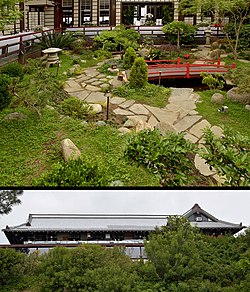Yamashiro is a Japanese word with kanji often meaning mountain castle (山城). There are however other kanji spellings.
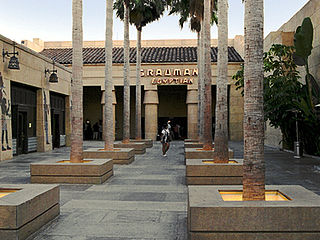
Grauman's Egyptian Theatre is a historic movie theater located on Hollywood Boulevard in Hollywood, Los Angeles, California. Opened in 1922, it is an early example of a lavish movie palace and is noted as having been the site of the first-ever Hollywood film premiere. From 1998 until 2020, it was owned and operated by the American Cinematheque, a member-based cultural organization.

Huell Burnley Howser was an American television personality, actor, producer, writer, singer, and voice artist, best known for hosting, producing, and writing California's Gold and his human interest show Visiting... with Huell Howser, produced by KCET in Los Angeles for California PBS stations. The archive of his video chronicles offers an enhanced understanding of the history, culture, and people of California. He also voiced the Backson in Winnie the Pooh (2011).

Griffith Park is a large municipal park at the eastern end of the Santa Monica Mountains, in the Los Feliz neighborhood of Los Angeles, California. The park includes popular attractions such as the Los Angeles Zoo, the Autry Museum of the American West, the Griffith Observatory, and the Hollywood Sign. Due to its appearance in many films, the park is among the most famous municipal parks in North America.

Descanso Gardens is a 150-acre (61 ha) botanical garden located in La Cañada Flintridge, Los Angeles County, California.

Canter's Deli is a Jewish-style delicatessen, opened in 1931 in Boyle Heights, and later moved to the Fairfax District of Los Angeles, California, near the border of West Hollywood, where it is now. It has been frequented by many notable movie stars and celebrities.

Angelino Heights, alternately spelled Angeleno Heights, is one of the oldest neighborhoods in Los Angeles. Situated between neighboring Chinatown and Echo Park, the neighborhood is known for its concentration of eclectic architectural styles from three eras: The Victorian, Turn of the Century and Revival eras. Carroll Avenue is listed on the National Register of Historic Places and there are over thirty Historic-Cultural Monuments in the neighborhood.

SS Lane Victory is an American Victory-class cargo ship used in World War II, the Korean War and Vietnam War. The ship was preserved in 1989 to serve as a museum ship in the San Pedro area of Los Angeles, California. As a rare surviving Victory ship, she was designated a U.S. National Historic Landmark.
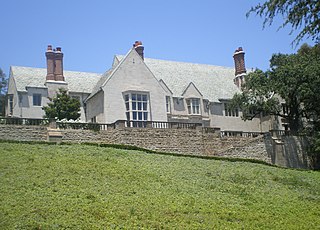
The Greystone Mansion, also known as the Doheny Mansion, is a Tudor Revival mansion on a landscaped estate with distinctive formal English gardens, located in Trousdale Estates of Beverly Hills, California, United States. Architect Gordon Kaufmann designed the residence and ancillary structures, and construction was completed in 1928. It was a gift from oil tycoon Edward L. Doheny to his son, Edward "Ned" Doheny, Jr. and his family. Following the purchase of the estate by the City of Beverly Hills in 1965, it became a city park in 1971, and was subsequently added to the National Register of Historic Places in 1976 as Doheny Estate/Greystone. The house and grounds are often used as locations for film and television shows. The house's descending staircase is one of the most famous sets in Hollywood.
Outpost Estates is a neighborhood in the Hollywood Hills of Los Angeles, California, consisting of about 450 homes. It is bordered by Mulholland Drive to the north, Franklin Avenue to the south, Runyon Canyon Park to the west, and Hollywood Heights and the Hollywood Bowl to the east.

The historic Subway Terminal, now Metro 417, opened in 1925 at 417 South Hill Street near Pershing Square, in the core of Los Angeles as the second, main train station of the Pacific Electric Railway; it served passengers boarding trains for the west and north of Southern California through a mile-long shortcut under Bunker Hill popularly called the "Hollywood Subway," but officially known as the Belmont Tunnel. The station served alongside the Pacific Electric Building at 6th & Main, which opened in 1905 to serve lines to the south and east. The Subway Terminal was designed by Schultze and Weaver in an Italian Renaissance Revival style, and the station itself lay underground below offices of the upper floors, since repurposed into the Metro 417 luxury apartments. When the underground Red Line was built, the new Pershing Square station was cut north under Hill Street alongside the Terminal building, divided from the Subway's east end by just a retaining wall. At its peak in the 20th century, the Subway Terminal served upwards of 20 million passengers a year.
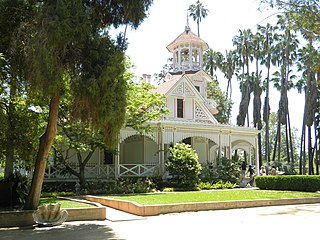
Queen Anne Cottage and Coach Barn is a Victorian style pair of buildings at Baldwin Lake, on the grounds of the Los Angeles County Arboretum and Botanic Garden, located in Arcadia and the San Gabriel Valley of southern California.

The Exposition Park Rose Garden is a historic 7-acre (28,000 m2) sunken garden located in Exposition Park in Los Angeles, California. It has been called "one of the city's best-kept secrets". It was added to the National Register of Historic Places in 1991.

Clifton's Cafeteria, once part of a chain of eight Clifton's restaurants, was the oldest surviving cafeteria-style eatery in Los Angeles and the largest public cafeteria in the world when it closed in 2018. Founded in 1931 by Clifford Clinton, the design of the restaurants included exotic decor and facades that were "kitschy and theatrical", and would eventually include multi-story fake redwood trees, stuffed lions, neon plants, and a petrified wood bar. Some considered Clifton's as a precursor to the first tiki bars. The name was created by combining "Clifford" and "Clinton" to produce "Clifton's".

RailGiants Train Museum is a railroad museum of historic trains located at the Fairplex in Pomona, California, United States. It is owned and maintained by the Southern California Chapter of the Railway & Locomotive Historical Society. The museum also operates the Fairplex Garden Railway. It has over 80 volunteers and from November through July, runs the second Sunday of every month, from 11:00am to 4:00pm, for the general public. The FGRR gears up every year for the L.A. County Fair, its primary show. In December various members run their Christmas trains. The garden railroad uses G Scale trains.

Pershing Square is a small public park in Downtown Los Angeles, California, one square block in size, bounded by 5th Street to the north, 6th Street to the south, Hill Street to the east, and Olive Street to the west. Originally dedicated in 1866 by Mayor Cristóbal Aguilar as La Plaza Abaja, the square has had numerous names over the years until it was finally dedicated in honor of General John J. Pershing in 1918.
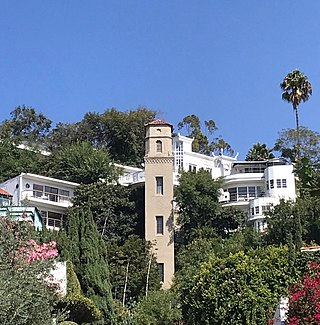
Hollywood Heights is a neighborhood in the Hollywood Hills of Los Angeles, bounded by the Hollywood Bowl on the north, Highland Avenue on the east, Outpost Estates on the west, and Franklin Avenue on the south. It includes a number of notable historic homes and buildings and has been home to numerous people in the film and music industries, dating back to the silent film era.

The Pig 'n Whistle was an American restaurant and bar located in Hollywood on Hollywood Boulevard.

The Saban Building, formerly the May Company Building, on Wilshire Boulevard in the Miracle Mile district of Los Angeles, is a celebrated example of Streamline Moderne architecture. The building's architect Albert C. Martin, Sr., also designed the Million Dollar Theater and Los Angeles City Hall. The May Company Building is a Los Angeles Historic-Cultural Monument. The building was operated as a May Company department store from 1939 until the store's closure in 1992, when May merged with J. W. Robinson's to form Robinsons-May. The building has been the home of the Academy Museum of Motion Pictures since 2021.

The Bernheimer Gardens were 8-acre 20th-century formal gardens in California in the United States that showcased a private collection of bronze statues from Asia.
